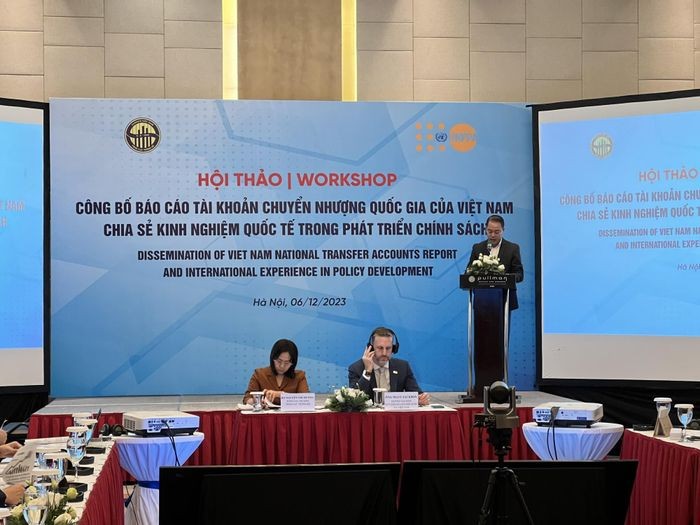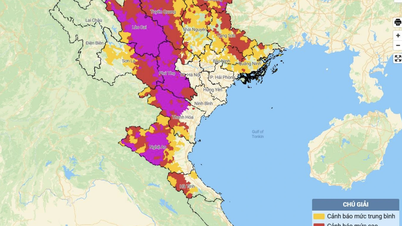The first demographic dividend period has ended, but Vietnam can synchronously deploy socio-economic solutions to increase labor productivity and encourage increased labor participation to achieve the second demographic dividend.
 |
| Ms. Nguyen Thi Huong, Director General of the General Statistics Office, spoke at the workshop, highlighting current population issues in Vietnam. (Photo: UNFPA) |
Sharing experiences and learning from international experiences to develop policies to take advantage of Vietnam's "golden population" in socio-economic development is an important goal at the workshop to announce the "Vietnam National Transfer Accounts Report" and learn from international experiences in applying data from the National Transfer Accounts study in policy development. The workshop was organized by the General Statistics Office in coordination with the United Nations Population Fund (UNFPA) on December 6 in Hanoi .
The National Transfer Accounts Report was completed within the framework of the development cooperation project between the General Statistics Office and UNFPA and with the technical support of Professor Sang Hyop Lee, PhD in Economics, University of Hawaii - international expert and Project Leader on National Transfer Accounts in Asia.
The importance of research methods
Ms. Nguyen Thi Huong, Director General of the General Statistics Office, affirmed: "National transfer accounts are a comprehensive and systematic method, used to describe the economy in detail through the economic life cycle and the reallocation of economic resources between generations."
According to Ms. Nguyen Thi Huong, this method helps countries improve their understanding of the generational economy as well as how generations affect economic growth and development. To date, research on National Accounts has been conducted and published by more than 70 countries in the world . This method not only proves its superiority in analyzing economic indicators through population age but also allows answering many important macro policy questions in which population is the center.
Further emphasizing the need for research on National Transfer Accounts, Mr. Matt Jackson, UNFPA Representative, said that this research process provides more evidence for the development of programs and policies to prepare for population aging.
The National Transfer Accounts provide a means of assessing the impact of demographic changes, including national income and public expenditure, spending, savings and investment. These data will assist policymakers in answering important questions related to economic growth, fiscal sustainability and intergenerational equity.
At the workshop, the General Statistics Office announced a number of important findings from the National Transfer Accounts research results. The research results show that the population of different ages will have different characteristics and levels of income and consumption. Children and the elderly often spend more than their income, in which children may spend more on education, while the elderly spend on health care. Adults often work and generate more income than they spend, but the income and expenditure structure between adults is also very different.
 |
| Overview of the Conference. (Photo: UNFPA) |
Ensuring "no one is left behind"
The difference between consumption and income of the population in general or in a certain age/age group with a positive value is called economic life cycle deficit, with a negative value is called economic life cycle surplus.
According to the General Statistics Office, the total life cycle deficit of Vietnam's population in 2022 is 364.6 trillion VND, equivalent to 3.8% of GDP. On average, the life cycle deficit of each Vietnamese person in 2022 is 3.7 million VND/person.
The Vietnamese population creates economic surplus value when they are between 22 and 53 years old. The most brilliant age for labor to create economic surplus belongs to the age group from 25 to 49 years old. Approximately 90% of the total surplus value of the whole society is created by labor in this age group. This is one of the disadvantages for Vietnam in the context of a rapidly aging population.
With the current population structure, Vietnamese people have about 31 years, corresponding to the age from 22 to 53 years old, to create a "lifecycle surplus". Meanwhile, the remaining 42 years (because the average life expectancy of Vietnamese people is 73.6 years old), corresponding to the age from 0 to 21 years old and from 54 years old and above, Vietnam will fall into a "lifecycle deficit". The period of economic deficit is longer than the period of economic surplus.
The General Statistics Office report affirms that, from the perspective of the National Transfer Account, the changes in the age structure of Vietnam's population today no longer bring advantages to the country's economic growth process. In other words, the period of the first demographic dividend has ended in Vietnam.
| "Demographic dividends don't happen just once. Populations can have a first, second, and even third demographic dividend." |
However, demographic dividends do not happen just once. Populations can have a first, second, and even third demographic dividend.
In Vietnam, the first demographic dividend period has ended, but Vietnam can synchronously deploy socio-economic solutions to increase labor productivity and encourage increased labor participation to achieve the second demographic dividend. In particular, if socio-economic development strategies and solutions are well implemented in accordance with the spirit of Decision No. 1305/QD-TTg of the Prime Minister (November 8, 2023), Vietnam will have an average labor productivity growth rate of 6.5%/year in the 2023-2030 period, 1.7 percentage points higher than the increase in 2022. This productivity growth will help Vietnam achieve the second demographic dividend by 2040.
Based on the research results, the General Statistics Office recommends a number of important policy suggestions and continues to affirm: Although from the perspective of the National Transfer Account, Vietnam no longer has an advantage in terms of population age structure, in terms of age structure, our country is still in the "golden population structure period" with an abundant young labor force.
It is forecasted that this period will last at least another 10 years. Therefore, policies to take advantage of the “golden population structure period”, especially policies to create jobs and satisfactory employment for workers, still have value and need to continue to be implemented well, ensuring sustainable growth and development to “Leave no one behind”.
Source


![[Photo] National Assembly Chairman Tran Thanh Man chairs the 8th Conference of full-time National Assembly deputies](https://vphoto.vietnam.vn/thumb/1200x675/vietnam/resource/IMAGE/2025/9/29/2c21459bc38d44ffaacd679ab9a0477c)

![[Photo] General Secretary To Lam receives US Ambassador to Vietnam Marc Knapper](https://vphoto.vietnam.vn/thumb/1200x675/vietnam/resource/IMAGE/2025/9/29/c8fd0761aa184da7814aee57d87c49b3)

![[Photo] General Secretary To Lam attends the ceremony to celebrate the 80th anniversary of the post and telecommunications sector and the 66th anniversary of the science and technology sector.](https://vphoto.vietnam.vn/thumb/1200x675/vietnam/resource/IMAGE/2025/9/29/8e86b39b8fe44121a2b14a031f4cef46)
![[Photo] Many streets in Hanoi were flooded due to the effects of storm Bualoi](https://vphoto.vietnam.vn/thumb/1200x675/vietnam/resource/IMAGE/2025/9/29/18b658aa0fa2495c927ade4bbe0096df)

































































































Comment (0)